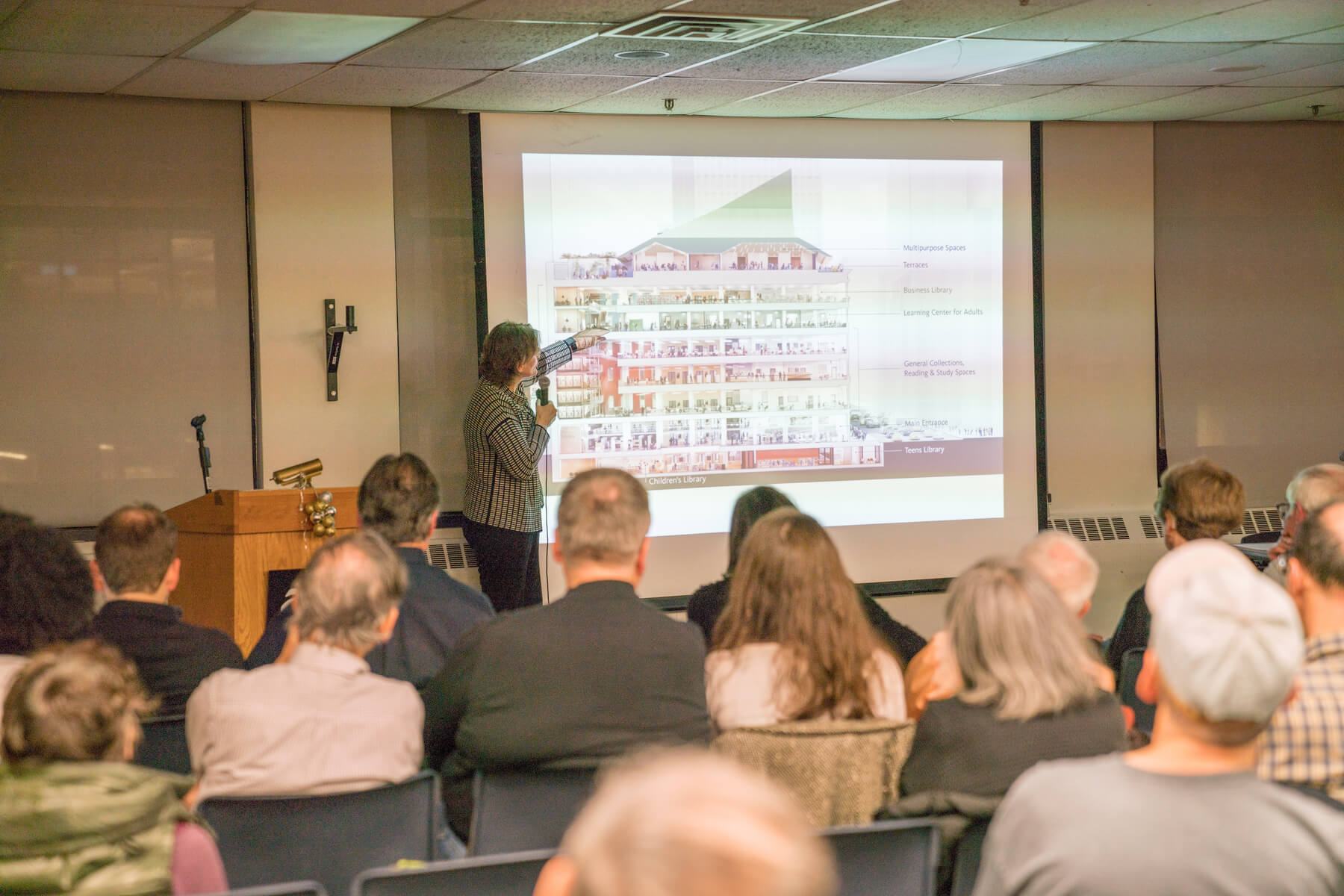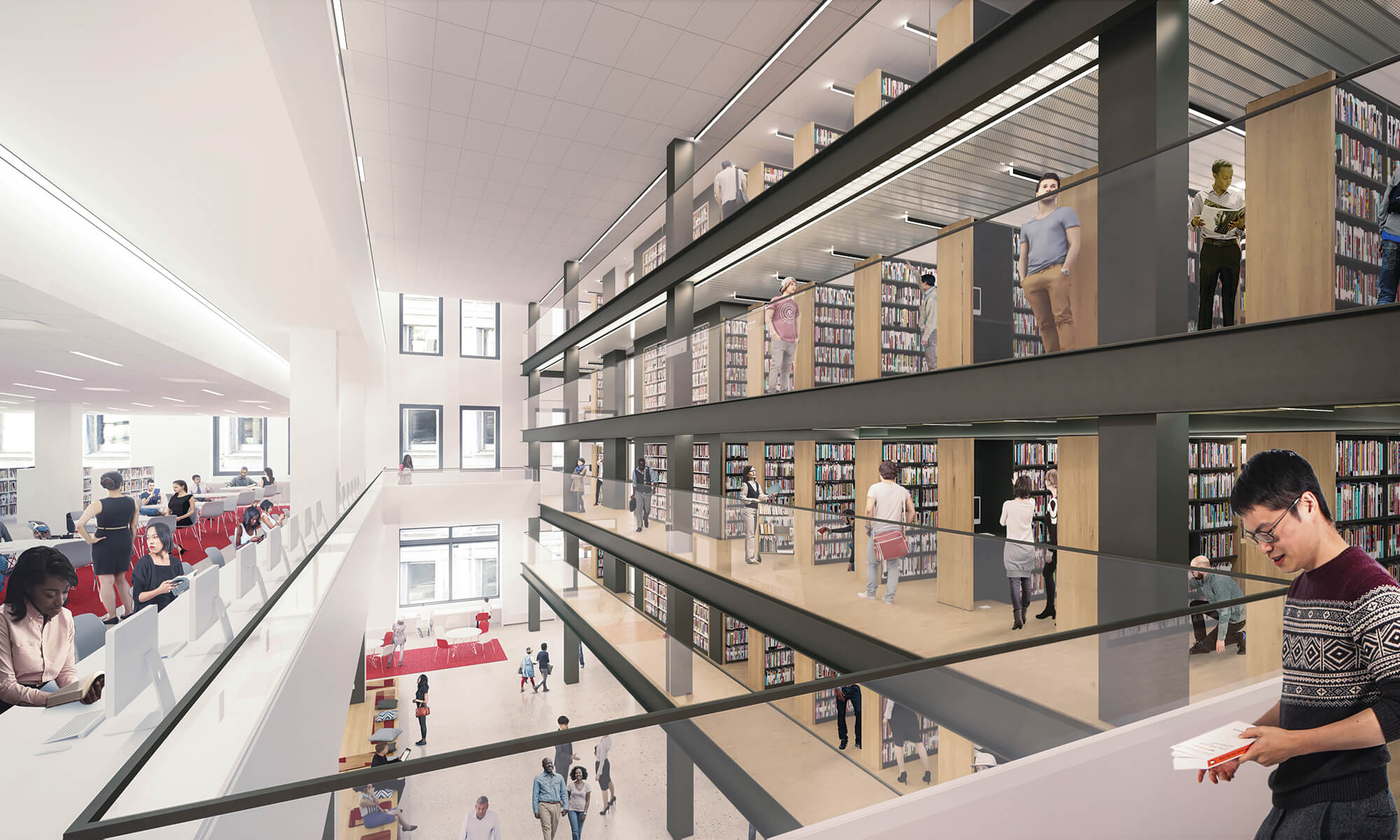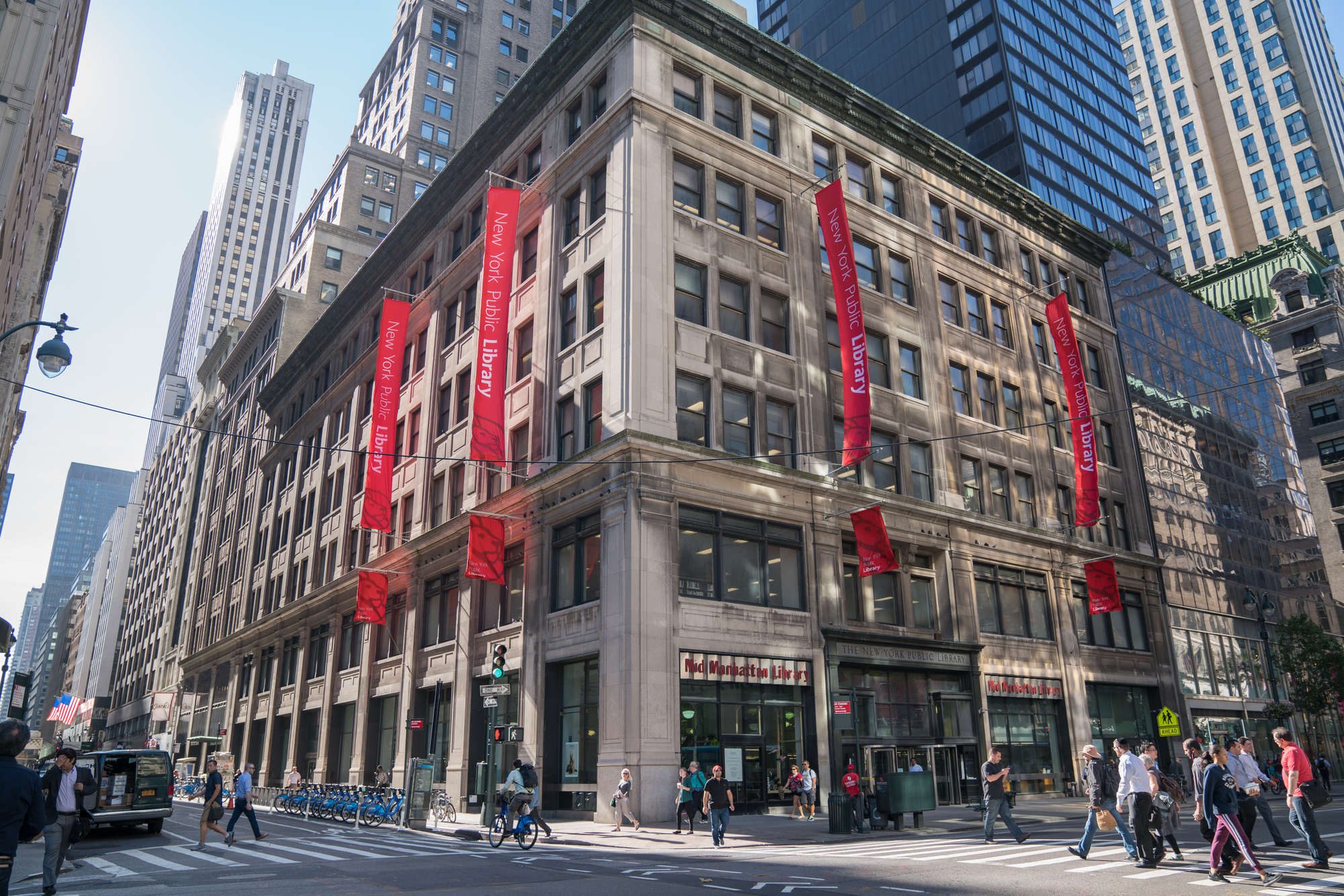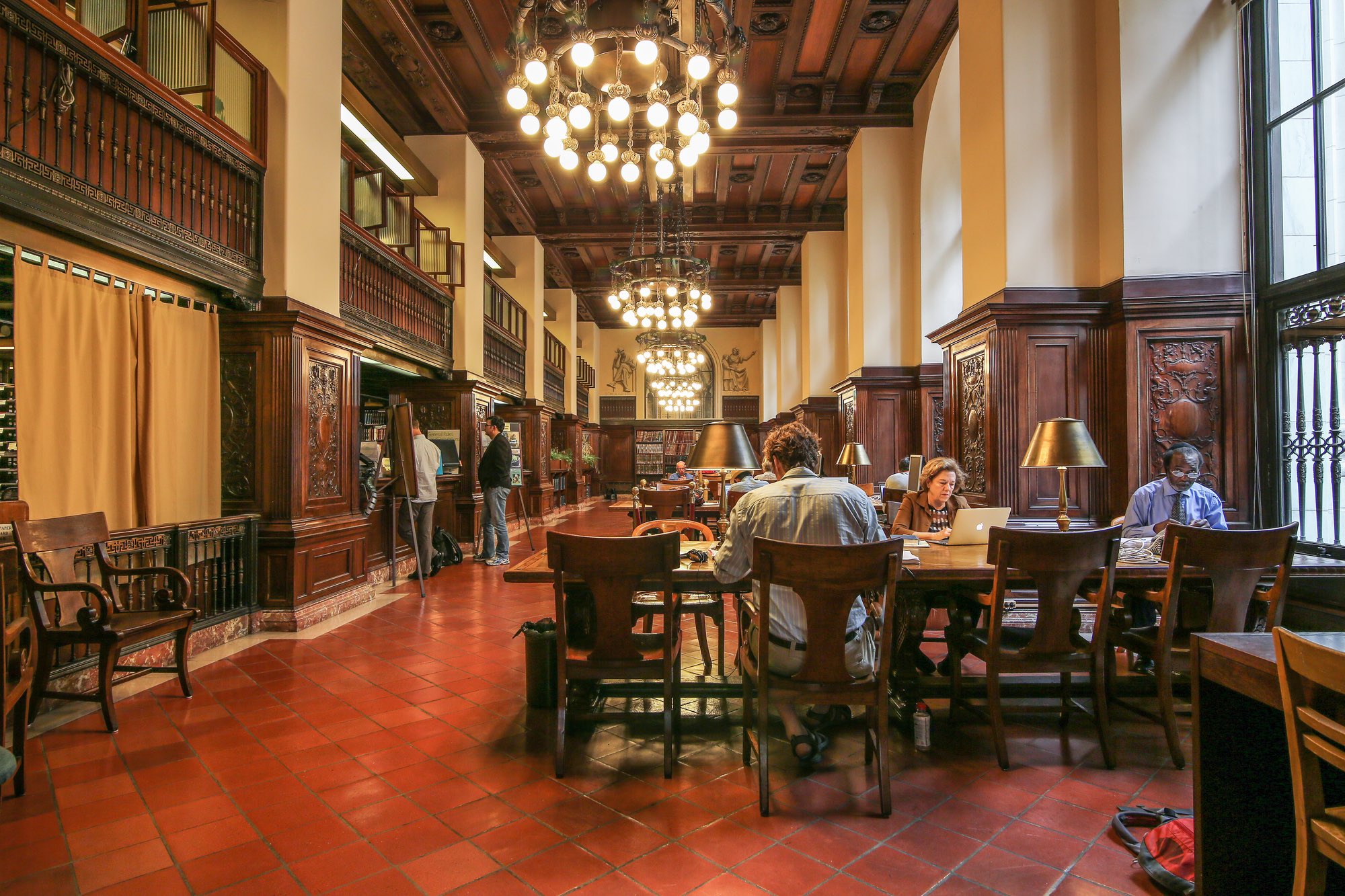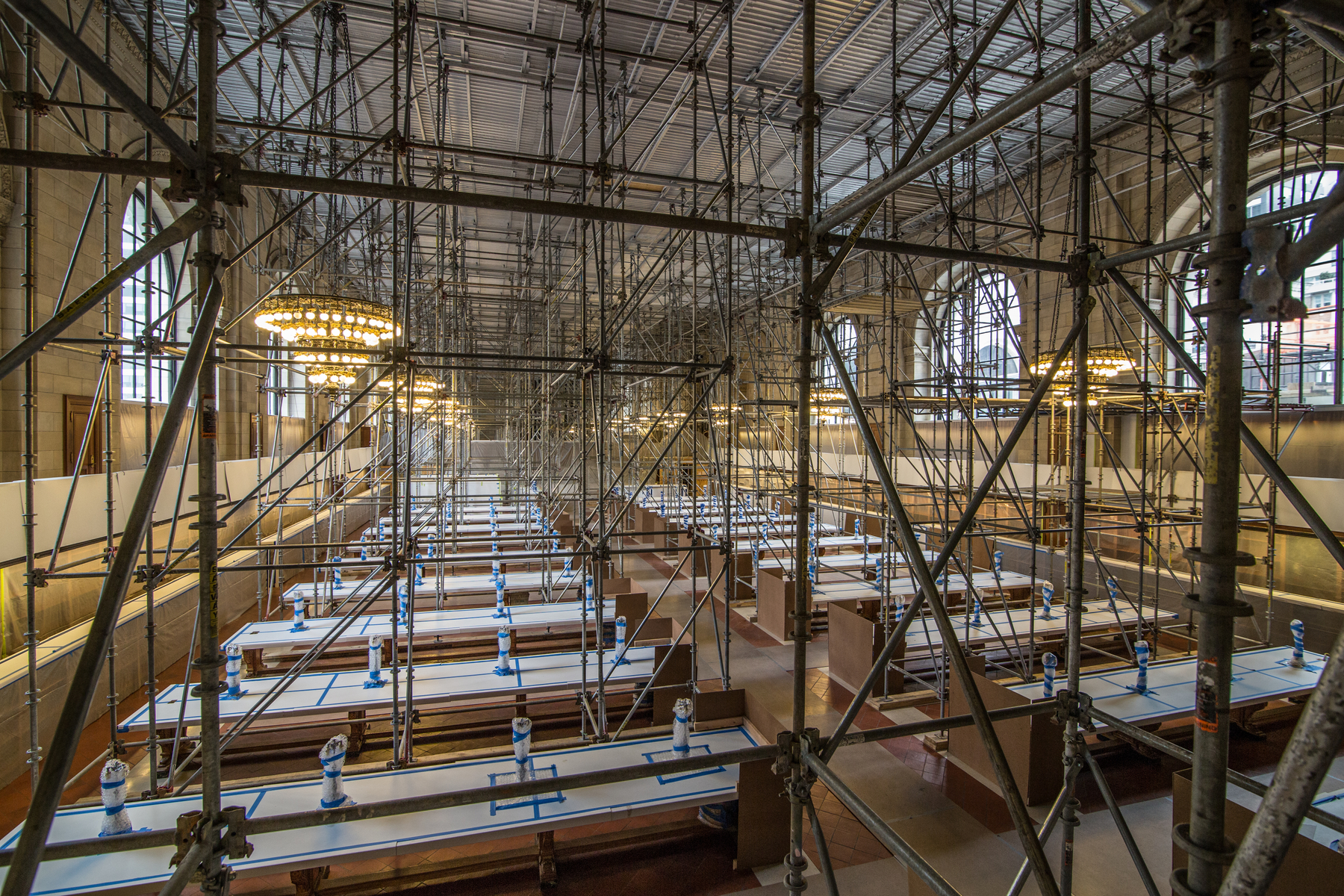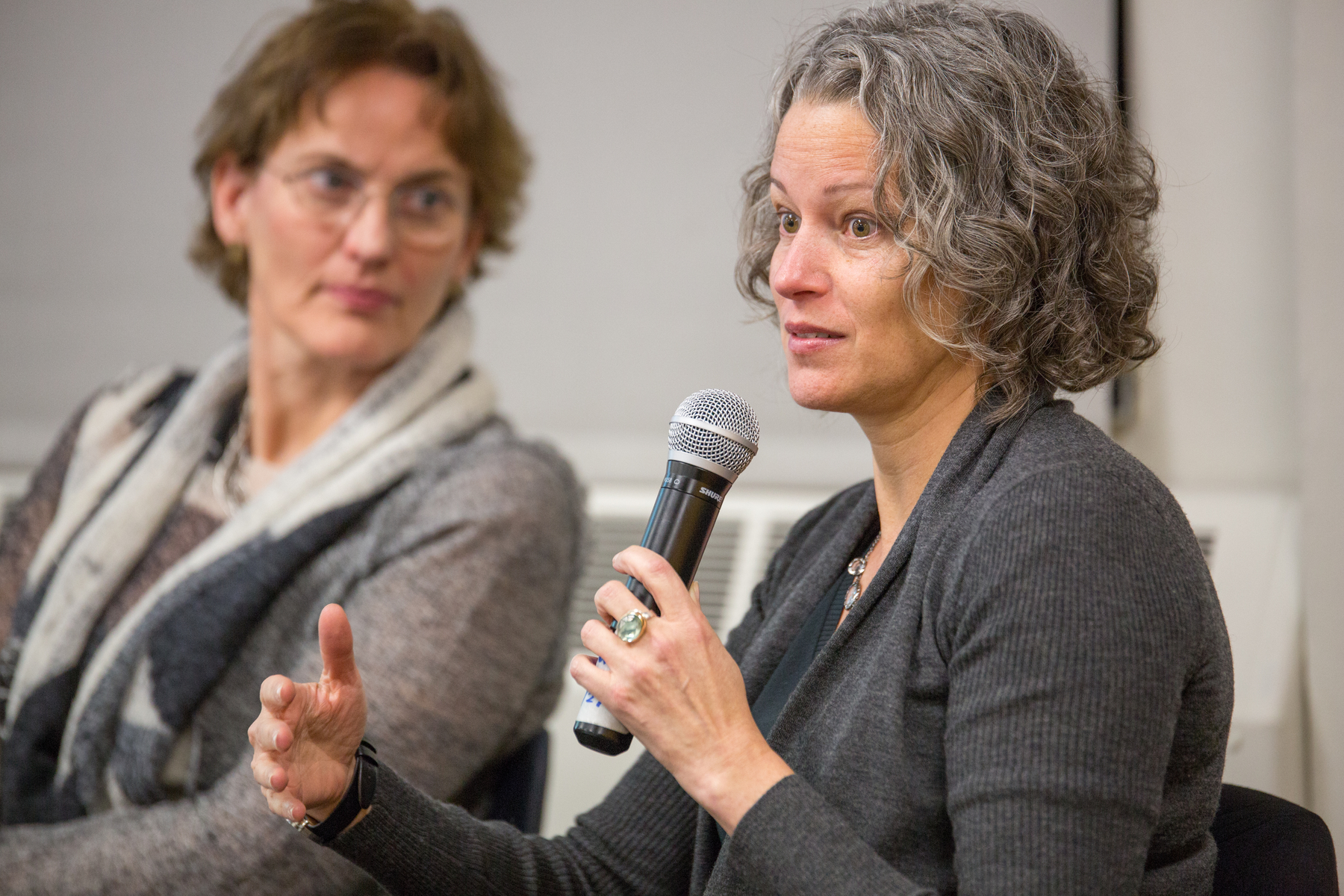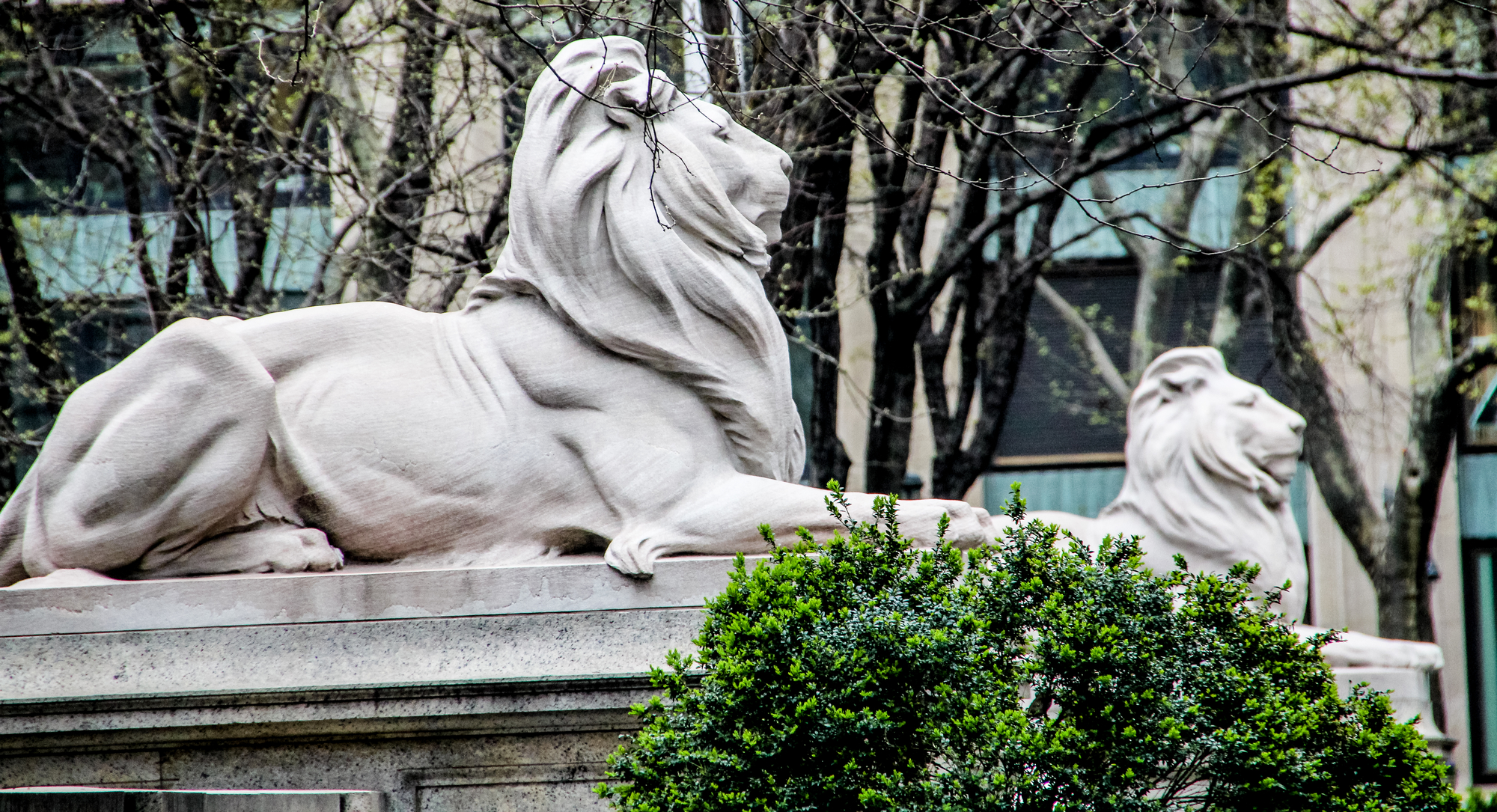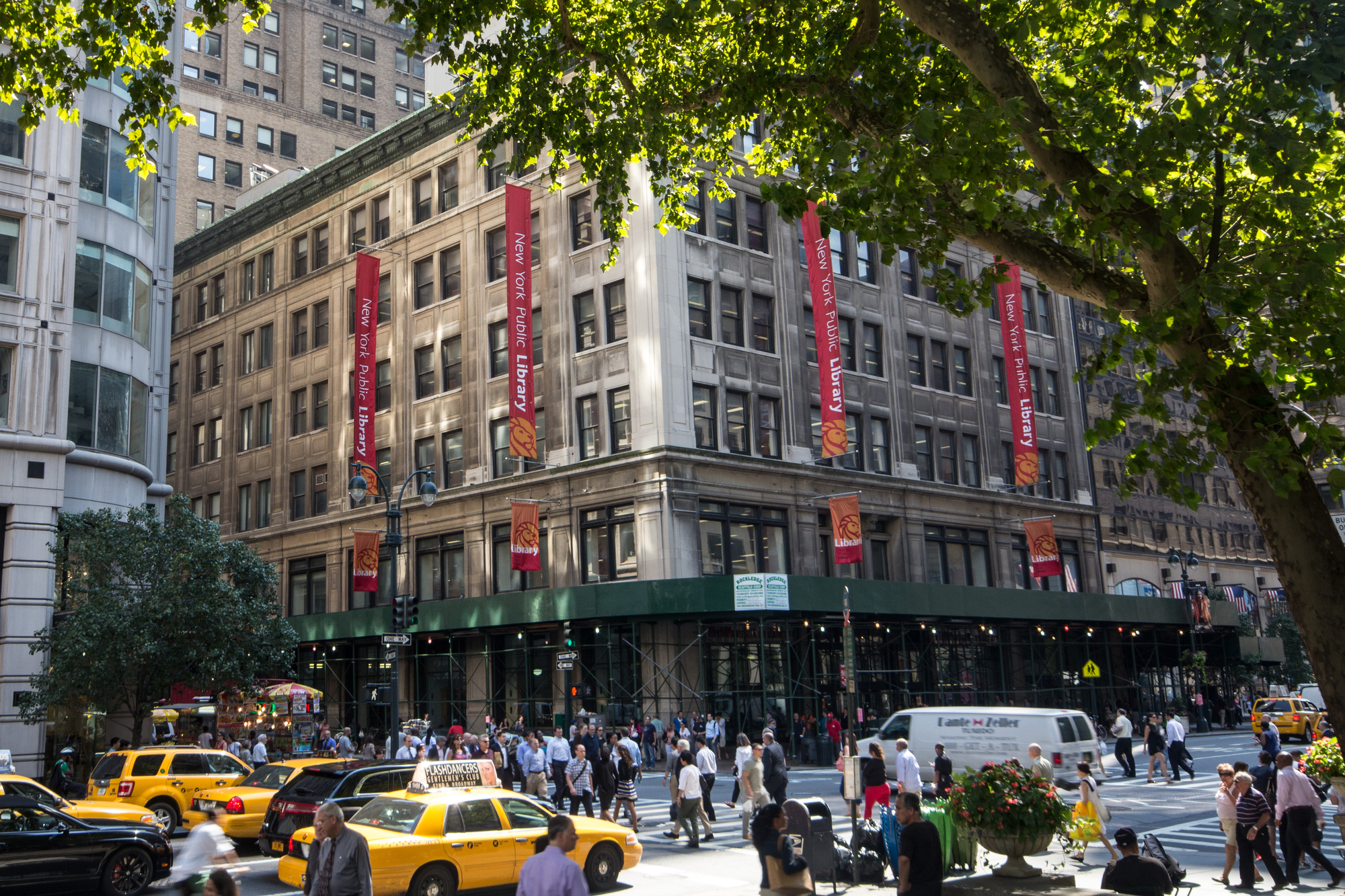The New York Public Library welcomed nearly 120 people to the sixth floor of the Mid-Manhattan Library on December 13 for a public meeting to discuss the building’s planned renovation and to share schematic designs. Members of the project design team – including architects Francine Houben of Mecanoo and Liz Leber of Beyer, Blinder, Belle – joined Library President Tony Marx, Chief Operating Officer Iris Weinshall, and Chief Branch Library Officer Christopher Platt at the 90-minute session to walk through the designs, discuss developing details of the plan, and share information about how midtown library service will be sustained while the Mid-Manhattan is closed for renovations (beginning in 2017).
The New York Public Library Unveils Early Design for the Renovation of Its Central Circulating Branch
NOVEMBER 16, 2016 – New Yorkers are getting their first look at a completely renovated, vastly improved Mid-Manhattan Library—The New York Public Library’s largest circulating branch—which is set to undergo a transformation that will increase seats, expand services, and add public space. The largest public-private rehabilitation in NYPL’s history will create a new, state-of-the-art library that will serve as both a model and catalyst for a rejuvenated library system.
The schematic design released by The New York Public Library provides an early idea of what the Midtown branch will look like after a complete interior renovation, which is scheduled to begin in 2018. The project is much-needed at Mid-Manhattan, which opened in the 1970s in a space originally designed for a department store. The branch receives approximately 1.7 million visits annually and circulates approximately 2 million items each year.
The schematic designs for the project were developed by the project’s design team, led by architects Francine Houben of Mecanoo and Elizabeth Leber of Beyer Blinder Belle. The team worked for over a year analyzing library usage data, interviewing staff, surveying the public, and meeting with community stakeholders to ensure that the new branch will best meet the needs of library patrons.
The renovated branch—located at Fifth Avenue and 40th Street—will have a dramatic, multistory wall of bookshelves; an employment skills center occupying a full floor as well as an adjacent floor providing job-search help and small-business support; a full-floor dedicated to a library for children and a separate library for teens; the only free public roof terrace in Midtown; and hundreds more seats than the current branch.
“New Yorkers will soon have the central circulating library that they need and deserve,” said NYPL President Tony Marx. “This library will transform lives by providing books, classes, and programs for New Yorkers of all ages, and it will transform our city—as it will be a model for how libraries can strengthen communities.”
Key elements of the new Mid-Manhattan Library include:
- An over 100,000-square-foot facility, providing more public space than the current Mid-Manhattan Library and Science, Industry and Business Library combined.
- More public space (by 35 percent) than the current Mid-Manhattan Library, created by moving back-office staff out of multiple floors of the building to an adjacent facility; utilizing the roof to add an additional floor; and utilizing the lower level for the public (with a design that brings in light from the street level).
- Capacity for approximately 400,000 books and other circulating materials.
- A “Long Room”—the largest element in the new branch—offering five floors of open, browsable book stacks, and two floors of meeting rooms. The shelves will all be located on one side of the building, maximizing capacity and efficiency.
- The only rooftop terrace in Midtown that will be free and open to the public.
- A dedicated business library occupying an entire floor and offering the services and circulating collections of the Science, Industry and Business Library.
- An adult learning center—one of the largest in the city—which will be adjacent to the business library and provide a seamless continuum of educational opportunities.
- A floor of dedicated space for children and teens; the current Mid-Manhattan does not have spaces for kids and teens.
- Approximately 17,000 square feet of general reading and study space—including seating for almost 1,500 library patrons, an increase of 30 percent over the combined capacity of the current Mid-Manhattan Library and Science, Industry and Business Library.
- Over 11,000-square-feet of multipurpose space that can be used for classes, events, one-on-one consultations, seminars, and a host of other programs, maximizing efficiency and diversity of public offerings.
“The building that was originally designed in 1914 to house the Arnold Constable department store will now really become a library,” said Francine Houben of Mecanoo, the project’s lead architect. “By creating the iconic Long Room for the circulating collection, dedicated spaces for children and teens, an adult learning center and business library, plus a rooftop destination for multipurpose use, the building will inspire serendipity and the discovery of all functions of a modern library.”
“The next phase of New York Public Library’s Midtown branch renovation is a great step toward moving New York’s public library into the 21st century,” said Mayor Bill de Blasio. “The city of New York is very lucky to have such an extensive system of public libraries, and when completed, this renovated library will offer New Yorkers even more opportunities to organize, learn and study. I look forward to seeing this plan move forward, and hope this project can be a model for others to follow.”
“The Mid-Manhattan Library will be a gleaming center for reading, research, and learning in the heart of the city,” said Manhattan Borough President Gale A. Brewer. “I’m proud to support this project and look forward to seeing these schematics and plans come to life.”
The new Mid-Manhattan Library will cost approximately $200 million, which includes a $150.7 million allocation for the project from New York City. The Library’s Board of Trustees approved the budget at its meeting tonight. The Library is currently fundraising for the project, as the remaining $50 million will come from private funds.
Mid-Manhattan will temporarily close for construction in late 2017. The renovated building will also include a business library incorporating services and resources currently housed at the nearby Science, Industry, and Business Library, which is slated to move out of its current building once the new Mid-Manhattan is ready to open. During construction, to maintain the large variety of services currently available at Mid-Manhattan, NYPL will use a combination of four Midtown buildings: the Stephen A. Schwarzman Building, on Fifth Avenue and 42nd Street; Grand Central Library; the Science, Industry and Business Library; and 53rd Street Library.
The Schwarzman Building—located across Fifth Avenue from Mid-Manhattan—will temporarily take in the primary functions of the branch, including its circulating collections, computer stations, and many of its public programs. Over the past three years, NYPL has greatly increased public space in the Schwarzman Building by reclaiming for public use several rooms on multiple floors that had been either vacant or used by staff. The Mid-Manhattan Library services will be relocated to spaces on the Schwarzman Building’s ground floor in an area originally designed for public use. The Library will outfit the ground floor rooms with shelving, tables, and more, first as a temporary site for Mid-Manhattan services, and then for continued use by the public after the branch reopens. Construction on the ground floor space—work that will not impact service in the rest of the building—will begin in 2017. The Schwarzman Building will also become the permanent home for Mid-Manhattan’s Picture Collection.
Grand Central Library will host Mid-Manhattan’s community resources, including IDNYC and SingleStop, while technology classes and programs will be moved to the Science, Industry and Business Library, which will remain open until the new Mid-Manhattan reopens.
Media Contact:
Angela Montefinise | angelamontefinise@nypl.org
About The New York Public Library
The New York Public Library is a free provider of education and information for the people of New York and beyond. With 92 locations—including research and branch libraries—throughout the Bronx, Manhattan, and Staten Island, the Library offers free materials, computer access, classes, exhibitions, programming and more to everyone from toddlers to scholars, and has seen record numbers of attendance and circulation in recent years. The New York Public Library serves approximately 18 million patrons who come through its doors annually and millions more around the globe who use its resources at nypl.org. To offer this wide array of free programming, The New York Public Library relies on both public and private funding. Learn more about how to support the Library at nypl.org/support.
Mid-Manhattan Renovation Update
The renovation of The New York Public Library’s largest circulating branch, Mid-Manhattan Library (MML), is proceeding on schedule, with schematic designs expected this calendar year and construction expected to begin in 2018.
As the Library prepares for construction, we have been planning how to accommodate patrons and staff during the temporary closure of MML, which is scheduled for fall 2017. Our objective is to maintain the large variety of services currently available at MML. We will accomplish this by using a combination of four of our Midtown buildings: the Schwarzman Building, Grand Central Library, Science, Industry & Business Library, and the new 53rd Street Library.
The Schwarzman Building will inherit the primary functions of MML. Its circulating collections, computer stations, and many of its public programs will be relocated to space on the ground floor of SASB, which was originally designed for public use, yet has been vacant or used by staff in recent decades. We will be outfitting these ground floor rooms with shelving, desks, and more—first as a temporary site for MML services, and then for continued public use after the new MML opens. Construction on this space – which will not impact service in the rest of the building – will begin in early 2017.
The Grand Central Library will host MML’s community resources, including IDNYC and SingleStop, and technology classes and programs will be moved to SIBL. Some of MML’s many public programs may also be moved to 53rd Street Library.
The Library will continue to update the public and provide opportunities for engagement throughout the Midtown renovation.
Rose Main Reading Room to Reopen October 5th
The New York Public Library’s historic Rose Main Reading Room and Bill Blass Public Catalog Room are scheduled to reopen on Wednesday, October 5. The two adjacent rooms on the third floor of the Library’s Stephen A. Schwarzman Building on Fifth Avenue and 42nd Street have been closed since May 2014 for repairs and restoration. The rooms will open during regular library hours; daily tours of the Schwarzman Building at 11 a.m. and 2 p.m. will include both spaces, which are designated for research and quiet study.
Research Matters: A Note from NYPL’s New Mellon Director of the Research Libraries
Dear Friends,
Last week I passed the two month mark in my position as the Library’s Mellon Director, and I thought it a good time to write to you about my initial experience at NYPL. To say that these remarks are provisional—subject to revision—is an understatement of the first order, but I’d like to share my initial impressions of the challenges we confront and the opportunities available to us.
For starters, I want to say what a privilege it is to serve the Library and the scholars and researchers who depend upon its resources. I need not tell you that the NYPL is the greatest public research library in the world, precious to all of us who care about the life of the mind. To work among and for others who embrace that view is a heartfelt joy and a deeply felt responsibility.
I’ll begin with the three goals I articulated when I accepted this position: enhance and preserve the research collections, support the work of readers who use them, and advocate for the importance of archival research. Pretty basic assumptions these. Think of them as a sculptor’s armature on which a fuller vision is to be fleshed.
That embodiment is very much a work in progress, but here’s where I am at this early stage. In terms of preservation and enhancement, the abundance of NYPL’s holdings is breathtaking. A conservative estimate would put the number of books, manuscripts, and other items at more than 45 million. Staggering, really. Enhance, in that context, means building on enormous strength, on the legacy of the Astor, Lenox, and Tilden Trusts and of the stewards who advanced those collections. We are called upon to continue that work both in highly visible ways—the recent acquisitions of NYRB and Tom Wolfe papers come to mind — and through other less celebrated additions that establish the ground for scholarly inquiry. To do so requires resources, of course, particularly in the form of dedicated endowments.
We also need to articulate a more comprehensive collection strategy. To some extent that endeavor is necessarily reactive—opportunistic—but it must be driven by something more: a set of principles shared across the four research libraries that articulate our goals, what we collect and why. One node of that conversation involves the question of “completeness,” an unsustainable ideal even for depository libraries. Simply put, there is too much material in the world, both in printed and digital forms, to sustain such ambition. This embarrassment of riches argues strongly for collaboration, the sharing of resources and responsibilities, a commitment to access rather than ownership. NYPL’s highly successful MaRLI program is a modest step in that direction. So too our ReCAP partnership with Columbia and Princeton, a venture which will add between 4 and 5 million entries to our catalog. Such cross-institutional cooperation opens the way to further initiatives, involving among other possibilities, collective purchasing strategies.
On the digital front, the prospects are tantalizing in the extreme. Joining with partners across the world to share collections and promote access to knowledge reignites the dream of Alexandria and evokes Melville’s vision of “genius, all over the world,” standing “hand in hand, and one shock of recognition runs the whole circle round.” We are in the earliest phase of this work, but as the greatest public research library in the world, a commitment to access framed in the broadest of terms, is inscribed in our DNA.
Access, of course, is bound up with preservation. New initiatives to accelerate the conservation of our holdings are underway. We are particularly focused on NYPL’s rare audio and moving image collections and on the creation of a more robust digital preservation environment. I note with pleasure, the impending appointment of a new collections manager to help us build a program to better identify the processing, preservation, and security needs of our special collections.
The second objective — supporting the work of readers — is why research libraries exist. We’re not dragons guarding a lair; we are partners in extending knowledge, pressing back the limits of human understanding. It’s no secret that relations between the Library and many of the researchers it serves have been frayed in recent years. My challenge is to help rebuild trust. I know that rhetoric is useless, and enhanced services are essential. To that end, I am pleased to report that two major capital projects in the Schwarzman Building are nearing completion. The restoration of the Rose Reading Room ceiling is ahead of schedule, and we will reopen both the Rose Room and the Bill Blass Catalog Room this fall. If you missed David Dunlap’s account of this work in a recent NYT article, here’s a link.
The construction of the second level of the Milstein Research Stacks under Bryant Park is also progressing on schedule. In April we will begin the six-month process of bringing 1.5 million items back from temporary storage. We will do so with care and deliberation, ensuring safe and accurate delivery and placement, while minimizing disruption to researchers who wish to call upon this material. When these 1.5 million items come home, we will have additional space for 1 million books and other items, bringing our onsite capacity to 4.3 million. We will have the room we need for new acquisitions, our most heavily requested items.
Beyond capital projects, we need to fix longstanding problems in our catalog and discovery layers, through which researchers access our collections. We are at work on that problem and look forward to the arrival of our new Chief Digital Officer who will help expedite that process.
Space is a particular challenge. Saying that scholarship is a contemplative activity, requiring quiet and inviolate space, may seem an antiquated notion, but it’s one I embrace. Universities have an easier time restricting access and ensuring such conditions. As a public institution, we confront a more difficult challenge, but the reopening of the Rose Reading Room presents an opportunity to address traffic flow and to rededicate the space to research. We are developing plans to do so.
We are blessed with an extraordinary staff of talented and devoted people. We need more of them and we need to make them more accessible to researchers. With NYC support, the Library has done a great job rebuilding staffing levels in the branch libraries. We look to expand that success to the four research libraries.
Objective three involves advocacy: speaking for the importance of serious research in an age of Wikipedia and Google. If we are not prepared to make the case, then who is? I’ll have more on this point in future letters, but for now let me say that I am preaching that gospel at every opportunity, highlighting the relationship between the material we hold and the work that it generates, arguing that what we own is less important than how we use it.
Finally, across these two months I’ve been aware of the risk of getting lost in strategy and process. I remind myself daily to ask “To what end?” In one sense the answer is obvious: aid and abet the generation of new knowledge, nurture the life of the mind, support the emergence of new ideas from earlier consensus. In another, it involves sustaining the excitement inherent in walking through the door to find oneself surrounded by the palpable evidence of human achievement. Alberto Manguel has spoken of that moment as a compensatory experience, a counter to the loss and disappointment inherent in the human condition. Libraries provide such compensation not only through the aspirational histories they house, but also by registering our unquenchable attraction to design, to meaning-making activity.
In 1832, Emerson visited Paris for the first time. His spirits were at low ebb. The death of two of his brothers and of his beloved wife from tuberculosis had accelerated the crisis of faith which troubled his consciousness. Paris did not immediately charm him; he described the city as “a noisy, uncomfortable, New York kind of place”. Adrift, he took himself to the Jardin des Plantes where he viewed the specimen cabinets arranged by Buffon and Jussieu. The order their designs imposed on the natural world was being upset by the influx of new world specimens, by the stirrings of what we have come to think of as the Darwinian Revolution. Categories judged to be fixed were becoming radically unstable, cabinets were bleeding one into another. Meaning making had become an urgent activity.
The shock of recognition Emerson experienced, the eclaircissement he found in the Jardin, was exhilarating. He felt great joy that he was alive to witness the birth of a new world. Moved by “strange sympathies” and by the “upheaving principle of life everywhere incipient,” he writes in his journal: “I will be a naturalist”. Like Emerson, we are lucky to be alive when new structures of thought and feeling are emerging, and fortunate in the extreme to be denizens of a library where such transits are marked, embraced, and preserved.
Happy Spring!
Warmly,
Bill
William P. Kelly
Andrew W. Mellon Director of the Research Libraries
The New York Public Library
Progress Report: Midtown Renovation Planning Process
From:
William Kelly, Andrew W. Mellon Director
Mary Lee Kennedy, Chief Library Officer
Iris Weinshall, Chief Operating Officer
We write to share a progress report on the renovation of The New York Public Library’s Midtown Campus.
Public Outreach
The engagement process we launched in the summer of 2014 has continued apace in recent months. In October 2015, the Library selected a design team for the Midtown Campus project, led by founder and creative director of Mecanoo, Francine Houben, and Beyer Blinder Belle partner Liz Leber.
The first step in this process involved meetings with internal and external stakeholders. In November, we invited Houben and Leber to address NYPL staff. In December, the Library hosted a public meeting with the design team and six external expert groups. That meeting addressed a wide range of topics and included a vibrant conversation.
Our objective for these, and for ongoing listening sessions, is to inform the design process with comments from the public and from experts in the field. To date, we have conducted email and on-site surveys (which generated nearly 16,000 responses); held a public town hall in March 2015; convened expert panels; traveled around the city to identify best practices; and met with library leaders around the nation whose institutions have undergone large renovations.
Related Midtown Campus Projects
The following work is taking place on the Midtown Campus:
- Rose Main Reading Room: As we noted in December 2015, the repair to the Reading Room ceiling is ahead of schedule. We are optimistic the Reading Room and the adjacent Bill Blass Public Catalog Room will reopen in fall 2016.
- Milstein Research Stacks: The creation of a new, lower level of storage underneath Bryant Park for the research collection is in its home stretch and on target for completion by April 2016. The upper and lower levels of the Milstein Research Stacks will provide a state-of-the-art storage environment for the Library’s collection. Here’s a video that shares some of the details of the work, which includes the installation of over 29,000 shelves.
- Mid-Manhattan Library Interim Service Planning: We expect to have a design plan for MML in place by fall 2016 and to begin work in the building by late 2017. We are currently discussing how and where the services of the Mid-Manhattan Library will continue during construction. Our team is hard at work on that task and will report back in the next four months.
Design Team RFP and RFQ
To provide additional background on some of the information driving the design team’s work, we’d like to share the Request for Qualifications (RFQ) that we provided to 24 firms when this project began, as well as the Request for Proposal (RFP) that was shared with 8 architecture teams.
We want to emphasize that these documents reflect thinking from a year ago. As the planning process has progressed, our overarching objective has remained constant: the creation of a revitalized Stephen A. Schwarzman Building and a state-of-the-art Mid-Manhattan Library. But the means to that end continue to evolve. While our objective in assembling the RFQ and RFP was to give the design team a sense of the project’s scope, the documents and their attachments were drafts—provisional measures that are in some respects out of date. Examples include representations of children’s and teen libraries in the Schwarzman Building, square footage charts that estimate the size of different facilities in the buildings, and—most importantly—diagrams that our space-planning consultant Brightspot created for individual floors of MML. These proposals suggest more finality than is warranted given ongoing public consultations and planning.
Our primary goals for the two buildings are easily stated. At Schwarzman, we are committed to the development of more quiet spaces for researchers and writers to work, the addition of research staff (and the space to accommodate them), and the enhancement of exhibition areas in which to showcase the Library’s extraordinary holdings. To achieve these ends, we will open areas of the Schwarzman Building that were designed for public use but have been either closed or dedicated to central administrative purposes for decades. At the Mid-Manhattan Library, our busiest facility, we will seek to serve our diverse and dynamic city in ever-better ways. Patrons seeking their next great read, adults taking classes, students studying after school, job applicants working on resumes, and entrepreneurs seeking advice will find a more welcoming and supportive environment.
Going Forward
Our planning process will be rigorous, and we are committed to making it thoughtful and inclusive. In the months ahead, the design team will tell us what they’ve learned and help us plot next steps. We will also articulate an interim service strategy for the Mid-Manhattan Library. We look forward to sharing those developments with you, and to providing continued opportunities for public input.
Community Meeting: Introducing the Midtown Renovation Design Team
On December 10, 2015, the Library invited key stakeholders and members of the public to an event to meet the Midtown renovation design team at the Mid-Manhattan Library. Francine Houben, founder and creative director at Mecanoo, and Liz Leber, partner at Beyer Blinder Belle, shared their respective portfolios of related work, and their approaches to similar large public projects. They were joined by NYPL leaders, including Chief Operating Officer Iris Weinshall and Chief Library Officer Mary Lee Kennedy. Following the brief presentations, the group took questions and feedback from attendees. For more information, please see the presentation made at the event.
Press Release: The New York Public Library to Begin Design of Midtown Renovations
Renowned architecture firm Mecanoo to lead renovation of Mid-Manhattan Library and Schwarzman Building
SEPTEMBER 16, 2015 – The New York Public Library will begin its Midtown renovation, and as a first step will begin designing the renovation of its central circulating branch, the Mid-Manhattan Library. Following a year of discussion and planning led by librarians and informed by expert and public feedback, the Library has selected Dutch architecture firm Mecanoo to lead the Midtown renovation. Led by founding partner and creative director Francine Houben, Mecanoo has designed award-winning libraries and public buildings around the world, and is renowned for its humanistic, accessible designs. The architect of record will be the New York City firm of Beyer Blinder Belle, whose award-winning renovations of historic buildings include Grand Central Terminal, Ellis Island, and New York City Hall.
The Midtown plan is a $300 million project to completely renovate and update the Mid-Manhattan Library, and to create increased public space, including for researchers and for exhibitions, at the iconic Stephen A. Schwarzman Building on 42nd Street. The plan will create a modern library experience in the heart of Midtown Manhattan for NYPL’s research, circulating, and business library functions.
The Mid-Manhattan Library – which received approximately 1.7 million visits last year – requires a complete interior renovation. The building will house a modern circulating library, a business library, a large education space, and spaces for public programs and classes. Construction on the building is expected to start in late 2017 and be complete in 2019. After the Mid-Manhattan renovation has begun, work will begin on expanding public space at the Stephen A. Schwarzman Building by approximately 42 percent. Currently vacant or underutilized staff spaces will be transformed into expanded and improved facilities for researchers and writers, public programming space to introduce teens and young adults to the research building and its treasures, and increased exhibition spaces. The project is being funded with city, state, and private money.
“Over 100 years ago, our City leaders knew that a great nation required a library that was the beacon of its largest city – and that couldn’t be more true today,” said Tony Marx, President of The New York Public Library. “This Midtown renovation will provide today and tomorrow’s New Yorkers the library they deserve to access information, study, write, enjoy our treasures, and all the other many wonderful forms of strengthening minds and our community at large that take place in a great library.”
NYPL Chief Library Officer Mary Lee Kennedy – who prior to NYPL led Harvard University’s library system – managed the year-long program planning process for the Library. The renovation project will be managed by NYPL Chief Operating Officer Iris Weinshall, whose extensive experience managing large capital projects includes overseeing the City University of New York’s multi-year capital construction program across 24 campuses in five boroughs, plus her tenure as Commissioner of NYC’s Department of Transportation.
Mecanoo was chosen for the Midtown Campus project after an eight-month selection process, and was unanimously approved today by the Library’s Board of Trustees. The firm’s extensive experience with libraries, as well as its reputation for accessible, respectful urban development, made it the ideal candidate for the unique project. Mecanoo’s many awards include the Stirling Prize nomination and the Civic Trust Award. Francine Houben is a Honorary Fellow of the AIA and was named Woman Architect of the Year in 2014. This fall, she will receive the Prins Bernhard Cultuurfonds Prize from Queen Máxima of the Netherlands. Partner Elizabeth Leber will lead the project for Beyer Blinder Belle, a firm that has won numerous awards, including the Presidential Design Award, the AIA Honor Award for Architecture, and the Historic Districts Council Landmarks Lion Firm Award.
The search process for the architect team was led by a joint staff and Trustee working group, led by the Chair of NYPL’s Board of Trustees, Evan Chesler. “With this team – Mecanoo, a worldwide leader in library design, and Beyer Blinder Belle, which has renovated New York’s most prominent and iconic historic buildings – the Library can be confident we can realize our ambitious, and critically important, vision,” said Chesler.
Mecanoo is currently renovating Washington, D.C.’s main circulating library, the Martin Luther King, Jr. Memorial Library, and designed the widely-renowned Bruce C. Bolling Municipal Building in Boston. It has designed acclaimed libraries such as the Library of Birmingham in Birmingham, England and the Delft University of Technology Library in the Netherlands, as well as theaters, community centers, and university buildings. Houben will move to New York for the design phase of the Mid-Manhattan Library renovation.
While planning, Mecanoo will utilize information and public feedback garnered over the last year by the Library in a variety of ways, including a large public planning session in March, over 15,000 surveys gathered from patrons online and in the Library’s Midtown buildings, small advisory groups of experts in key topics (including K-12 education and research), and site visits to fellow New York City institutions. Additional public feedback sessions will be scheduled in the future, and the firm will begin extensive outreach to internal library stakeholders and the public this fall.
“Libraries are the cathedrals of our time. It is the most important public building in a city,” said Houben. “Our holistic approach – from library card to campus – aims to create a public library in the broadest sense, welcoming to all and capable of changing the course of individual lives through innovative library spaces and services, for today and tomorrow. It is a great honor to have been selected for this project.”
The project complements NYPL work already happening in Midtown, including the construction of a second level of state-of-the-art collections storage beneath Bryant Park, connected to the Stephen A. Schwarzman Building. The new level will hold 2.5 million items – joining the 1.5 million materials currently residing in the upper level of Bryant Park storage – and will allow the Library to store as many or more research items on-site at the Stephen A. Schwarzman Building as ever before. The additional level of storage – to be called, along with the existing level, the Milstein Research Stacks – is expected to be complete early next year.
For ongoing information on this project, check nyplmidtown.org/updates.
Media Contact:
Angela Montefinise | angelamontefinise@nypl.org
About The New York Public Library
The New York Public Library is a free provider of education and information for the people of New York and beyond. With 92 locations—including research and branch libraries—throughout the Bronx, Manhattan, and Staten Island, the Library offers free materials, computer access, classes, exhibitions, programming and more to everyone from toddlers to scholars, and has seen record numbers of attendance and circulation in recent years. The New York Public Library serves more than 18 million patrons who come through its doors annually and millions more around the globe who use its resources at www.nypl.org. To offer this wide array of free programming, The New York Public Library relies on both public and private funding. Learn more about how to support the Library at nypl.org/support.
Community Meeting: Midtown Renovation Planning Session
Many thanks to the wide range of New Yorkers who participated in the Library’s Midtown renovation planning session for services and programs on Thursday, March 26, 2015, in the Stephen A. Schwarzman Building. After a presentation on the program planning to date, participants broke into small groups to share ideas, questions, and opinions about the Library’s plans.
For more information, please see the presentation and summary notes from the individual group discussions on Research, Core Services, Business, PK–12, and Adult Education.
